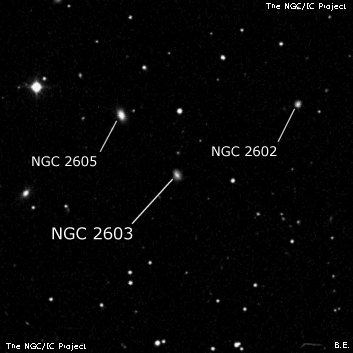
R.J. Mitchell, Lord Rosse's assistant, discovered NGC 2603 and 2605 on 11 Mar 1858. Although he made a sketch of 4 galaxies (out of 6 total in the group), the identifications have been confused (seen notes for NGC 2602). NGC 2602 (discovered by John Herschel) is labeled Gamma and NGC 2606 is labeled Delta. Of the two remaining galaxies, the logical assignment is NGC 2603 = Alpha = LEDA 3133653 and NGC 2605 = Beta = LEDA 2424112. Alpha was noted as "F, S, bM." JH assumed Alpha = NGC 2602 when compiling the GC, so he placed NGC 2603, as well as NGC 2605, following NGC 2602 instead of preceding.
RNGC misidentifies LEDA 2423840, the faintest galaxy in the group, as NGC 2603. LEDA 2423840 was noted on Sir Robert Ball's observation on 5 March 1867 (preceding NGC 2606 by 118" in PA 90°), but it didn't receive a NGC designation as Dreyer was not sure which two nebulae were described in this observation. The MCG entry for NGC 2603 (MCG +09-14-072) probably applies to much brighter NGC 2606 as there are no other nearby MCG entries. At ~785 million light years (z = 0.057), this is certainly one of the most distant galaxies in the NGC.
400/500mm - 18" (3/13/10): not found at 275x.
600/800mm - 24" (3/13/10): at 320x appeared extremely faint and small, round, 6" diameter. Required averted vision to momentarily view, but reaquired several times to confirm. Located 5.0' W of NGC 2602 and 10' WNW of NGC 2606. Faintest of 5 galaxies in a group with brightest member NGC 2606. At B = 16.9, this is one of the faintest, if not the faint NGC galaxy.
Notes by Steve Gottlieb